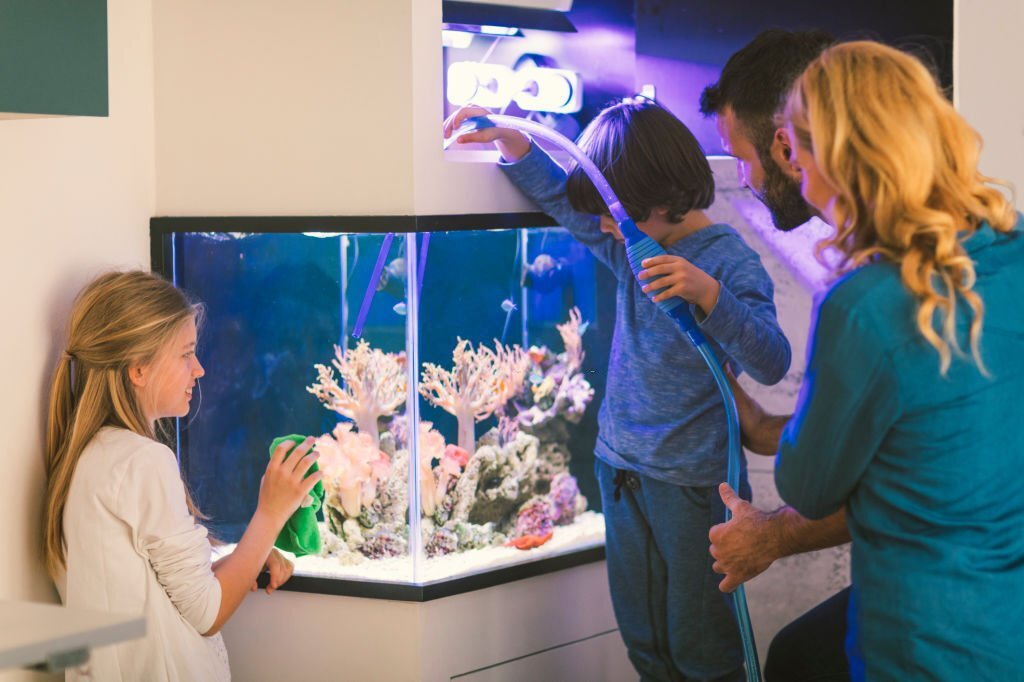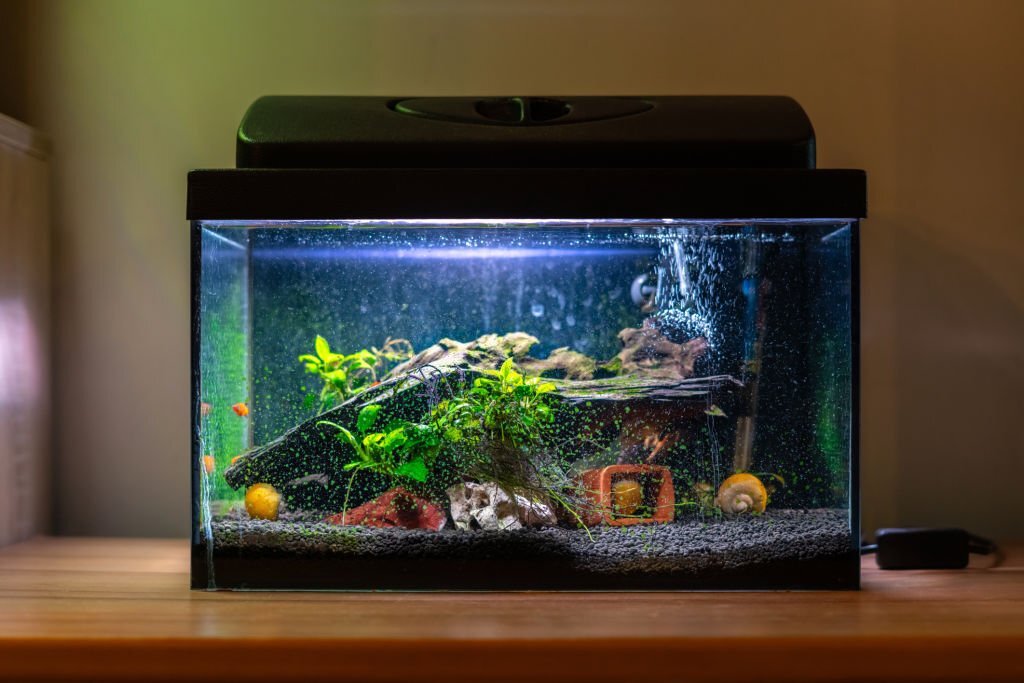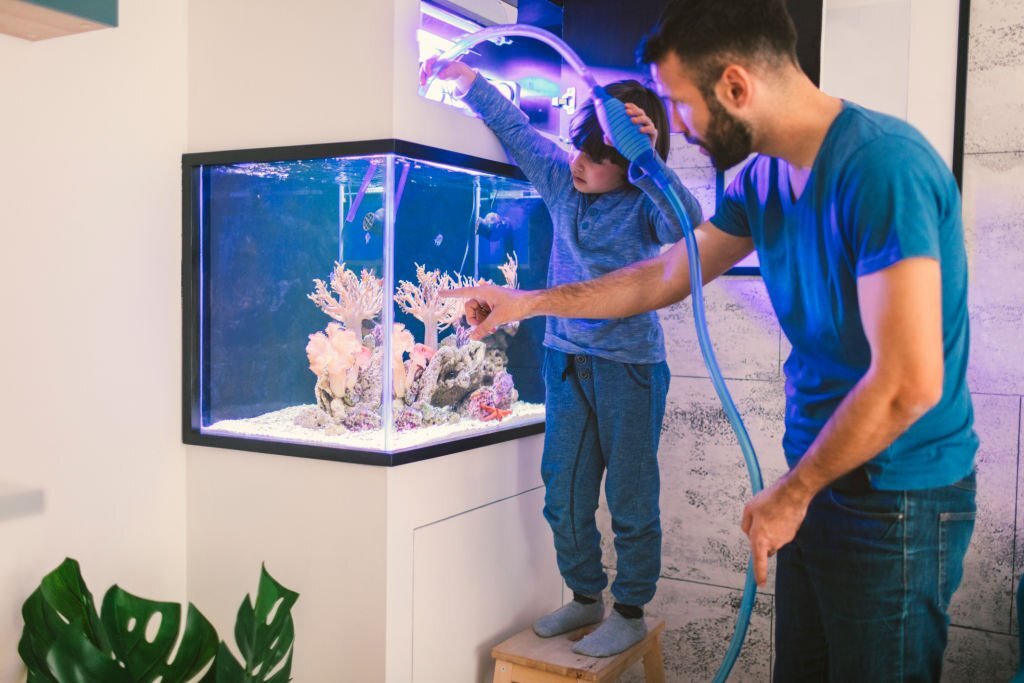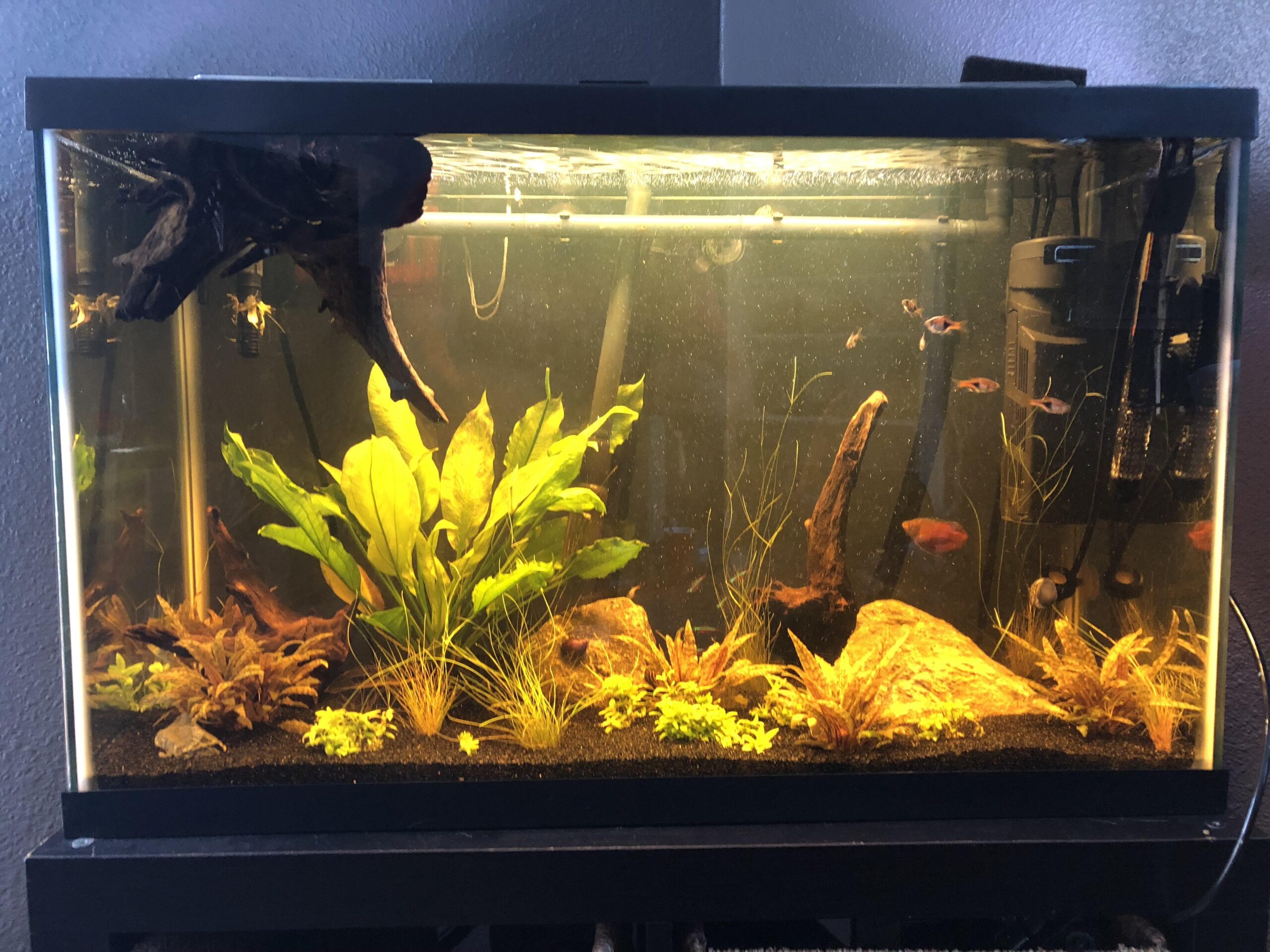Smartplantedaquarium.com participates in affiliate marketing programs. We may earn commissions on purchases made through our affiliate links. This doesn't affect our content or recommendations and we only recommend products we would put in our own tanks.
Maintaining a clean and healthy environment for your aquatic friends is essential for their well-being. One crucial aspect of aquarium care is changing the water. In this guide, we’ll walk you through the steps to ensure that the process is smooth and stress-free for both you and your beloved fish.
Whether you’re a seasoned aquarist or just starting out, these simple tips will help you keep your aquarium water crystal clear and your aquatic companions happy.
Contents
Key Takeaways
- Regular water changes are important for maintaining a clean and healthy environment for aquatic fish.
- Water changes remove toxins, replenish essential nutrients, maintain water clarity, stabilize pH and hardness levels, prevent disease outbreaks, and control algae growth.
- The frequency of water changes depends on the type of aquarium and its inhabitants, with guidelines ranging from weekly to every few days.
- To change aquarium water, gather the necessary supplies, turn off equipment, start the siphon to remove old water and clean the substrate, prepare new water by matching temperature and treating with water conditioner, refill the aquarium slowly, restart equipment, monitor aquatic life and test water parameters, and clean and store supplies.
- Additional considerations include understanding the properties of the water source (tap water or RO/DI water), avoiding temperature shock, acclimating new additions, avoiding over-cleaning, maintaining filters, planning for absences, monitoring equipment, and keeping a log of water changes and observations.
- Always use dechlorinated water and take your time to minimize stress for the fish during the water change process.
Why Are Water Changes Important
In the aquatic world, the significance of regular water changes cannot be overstated. Here’s an in-depth look at why changing the water in your aquarium is crucial:
- Toxin Removal: Over time, waste products like ammonia, nitrites, and nitrates accumulate in the aquarium water. Though beneficial bacteria can convert ammonia to less harmful substances, the resultant nitrates still need to be diluted or removed. Regular water changes help in reducing these toxin levels, ensuring a healthier environment for your aquatic life.
- Nutrient Replenishment: Water changes reintroduce essential minerals and trace elements that fish and plants require for optimal health. Over time, these nutrients are consumed by aquatic life and plants, or they precipitate out of the water. Fresh water restores these vital elements.
- Water Clarity: Organic compounds, food residues, and waste can make the water cloudy or discolored. Regular water changes help in maintaining the clarity and aesthetic appeal of the aquarium.
- pH and Hardness Stability: The pH and hardness of water can shift over time due to various chemical processes in the tank. Introducing fresh water can help stabilize these parameters, ensuring they stay within a range suitable for the tank’s inhabitants.
- Disease Prevention: An accumulation of waste and toxins can stress fish, making them more susceptible to diseases. By diluting potential pathogens and removing waste, water changes can reduce the risk of disease outbreaks.
- Algae Growth Reduction: Excess nutrients, especially nitrates and phosphates, can fuel unwanted algae growth. Regular water replacements can help in controlling these nutrient levels, thereby curbing excessive algae proliferation.
In essence, just as we need clean air to breathe, fish need clean water to thrive. The process of changing the water mimics the natural flow and renewal of water in wild habitats, offering fish a closer experience to their native environments. Regular water changes are an essential aspect of aquarium maintenance, ensuring a balanced, healthy, and vibrant aquatic ecosystem.
Frequency of Water Changes
| Aquarium Type | Recommended Water Change |
|---|---|
| Established Aquariums | 10-20% weekly or 25-30% every 2-3 weeks |
| New Aquariums | 10-15% every few days |
| Marine Aquariums | 10-15% every 2 weeks |
| Reef Aquariums | 5-10% weekly or 15-20% every 2-3 weeks |
| Densely Stocked Tanks | Varies based on bio-load |
| Planted Aquariums | Based on plant health and water tests |
| Specialty or Breeding Tanks | Unique requirements for reproduction |
Determining the ideal frequency for changing aquarium water is essential for maintaining a stable and healthy environment for your aquatic inhabitants. While the specific needs can vary based on the type of aquarium and its inhabitants, here are some general guidelines:
- Established Aquariums: For most freshwater tanks that are well-established, it’s advisable to change 10-20% of the tank’s water every week or 25-30% every 2-3 weeks. This routine helps in keeping the water parameters stable and ensures that toxins don’t build up to dangerous levels.
- New Aquariums: Newly set up aquariums haven’t yet developed a mature biological filter. As a result, they might require more frequent water changes, such as 10-15% every few days, until the nitrogen cycle is established and stable.
- Marine Aquariums: Saltwater or marine tanks often have more sensitive and diverse biological loads. It’s generally recommended to change 10-15% of the water every 2 weeks. However, this can vary based on the specific needs of the tank’s inhabitants and the bio-load.
- Reef Aquariums: Coral reef tanks, housing various corals, invertebrates, and fish, can have even more specific needs. Typically, a 5-10% water change every week or 15-20% every 2-3 weeks is suitable.
- Densely Stocked Tanks: Aquariums with a high bio-load, meaning they house a large number of fish relative to their size, may require more frequent or larger water changes. Monitoring water parameters, especially ammonia, nitrite, and nitrate levels, is crucial in such cases.
- Planted Aquariums: While plants can absorb some of the waste products, balancing the needs of aquatic plants and fish can be challenging. Regular water testing and observing plant health can guide the frequency and volume of water changes.
- Specialty or Breeding Tanks: Some specialized tanks, such as those used for breeding, might have unique water change requirements to maintain optimal conditions for reproduction.
Remember, while these are general guidelines, every aquarium is a unique ecosystem. Regular water testing is the best way to determine the specific water change needs of your tank. Observing the behavior and health of your fish, as well as the overall appearance and clarity of the water, can also provide valuable insights. Adjusting the water change frequency based on these observations and test results ensures a thriving environment for your aquatic community.
How to Change Aquarium Water
Changing aquarium water is a crucial maintenance task that ensures the health and well-being of your aquatic inhabitants. Here’s a comprehensive, step-by-step guide on how to do it:
Step 1 – Preparation
- Gather Supplies: Ensure you have all the necessary equipment at hand. This includes a siphon or gravel vacuum, buckets, water conditioner, a thermometer, and clean towels or rags.
- Turn Off Equipment: Before starting, turn off all aquarium equipment, especially heaters and filters, to prevent any potential damage or electrical hazards.
Step 2 – Removal of Old Water
- Start the Siphon: Place one end of the siphon or gravel vacuum into the tank and initiate the water flow according to the device’s instructions.
- Clean the Substrate: If using a gravel vacuum, move it slowly through the substrate to remove accumulated detritus and waste. This not only removes water but also cleans the tank’s bottom.
- Remove the Desired Amount: Depending on the type of aquarium and its needs, remove the appropriate amount of water, typically between 10-30% for routine changes.
Step 3 – Prepare New Water
- Match Temperature: Use a thermometer to ensure the new water is close to the aquarium’s current temperature. Sudden temperature changes can stress aquatic life.
- Treat the Water: Add an appropriate water conditioner to the fresh water. This neutralizes chlorine and chloramines, which are commonly found in tap water and are harmful to fish.
- Adjust pH and Hardness (if necessary): If your tap water’s pH or hardness differs from the desired levels for your aquarium, make necessary adjustments using available products.
Step 4 – Refilling the Aquarium
- Gently Pour the Water: To avoid disturbing the substrate or decorations, pour the new water slowly. Using a clean plate or bowl placed in the tank can help disperse the flow.
- Check Water Levels: Ensure that the water level is back to its original position, leaving some space at the top to provide adequate oxygen exchange.
Step 5 – Restart Equipment
- Turn On the Heater and Filter: Once you’ve refilled the tank, restart the heater and filter. Ensure the equipment is functioning correctly.
- Check for Air Bubbles: Sometimes, air can get trapped in the filter after a water change. If you notice excessive bubbling or noise, consult the filter’s manual for guidance on removing trapped air.
Step 6 – Monitor Aquatic Life
- Observe Fish Behavior: After the water change, keep a close eye on your fish and other inhabitants. Ensure they are behaving normally and show no signs of stress.
- Test Water Parameters: A day after the water change, it’s a good practice to test the water parameters to ensure everything is within the desired range.
Step 7 – Cleanup
- Rinse Equipment: Clean and rinse the siphon or gravel vacuum and any other tools used.
- Store Supplies: Store all your equipment and supplies in a clean, dry place, ready for the next water change.
Other Things to Consider When Changing Aquarium Water
While the step-by-step guide provides a comprehensive approach to changing aquarium water, there are additional nuances and considerations that can optimize the process and ensure the well-being of your aquatic inhabitants:
- Water Source:
- Tap Water: Most hobbyists use tap water for their aquariums. Ensure you understand the properties of your tap water, such as its pH, hardness, and chlorine/chloramine content.
- RO/DI Water: Some aquarists use reverse osmosis or deionized water, especially for sensitive species or reef tanks. This water is stripped of most contaminants but also lacks essential minerals, so it often requires remineralization.
- Temperature Shock: Even slight variations in water temperature can stress fish. Use a reliable aquarium thermometer and, if needed, an aquarium heater to adjust the temperature of the new water.
- Acclimatization: If you’re introducing new fish or plants to the tank after a water change, ensure you acclimate them properly to avoid shock from differences in water parameters.
- Avoid Over-cleaning: While it’s essential to keep the aquarium clean, over-cleaning can strip the tank of beneficial bacteria. These bacteria are crucial for breaking down waste and maintaining the nitrogen cycle.
- Water Conditioners: Apart from neutralizing chlorine and chloramines, some water conditioners also bind heavy metals and other contaminants, making them safe for aquatic life.
- Aquarium Decor: During water changes, it’s a good opportunity to gently clean decorations or rearrange them if desired. However, avoid making drastic changes to the setup as it can stress the inhabitants.
- Filter Maintenance: While not always necessary during every water change, it’s a good practice to check your filter. Clean or replace filter media as required, but avoid cleaning all media at once to retain beneficial bacteria.
- Plan Ahead for Absences: If you’re planning to be away from home, consider doing a water change before you leave and ensure someone can check on the aquarium or use automated systems.
- Monitoring Equipment: Regularly inspect equipment such as heaters, filters, and lights for any signs of wear or malfunction.
- Keep a Log: Maintaining a logbook of water changes, water parameters, and any observations can be invaluable. It helps track the health of the aquarium over time and can assist in diagnosing any issues.
Conclusion
Changing aquarium water is a crucial aspect of maintaining a healthy and thriving aquatic environment for your fish and other aquatic inhabitants. Regular water changes help remove harmful pollutants, replenish essential nutrients, and maintain stable water parameters.
By following the steps outlined in this guide and adhering to a consistent water change schedule, you can provide your aquatic pets with a clean and stable habitat that promotes their well-being and longevity.
Remember to always use dechlorinated water and take your time during the process to minimize stress for your fish.
Frequently Asked Questions
1. How long to change aquarium water?
Typically, the process of changing 10-30% of the aquarium water, which is recommended for most tanks, takes anywhere from 30 minutes to an hour, depending on the tank size and the tools used. However, the time can vary based on individual situations and needs.
2. Can I change 100% of aquarium water?
It’s generally not recommended to change 100% of the aquarium water at once. Doing so can remove beneficial bacteria, disrupt the tank’s biological balance, and stress the inhabitants. If you feel a complete water change is necessary due to severe contamination, it’s essential to take precautions like saving some of the original water and ensuring the new water matches the old in temperature and parameters.
3. What kills fish after water change?
Several factors can lead to the death of fish after a water change. One of the primary culprits is temperature shock, which occurs when there’s a significant discrepancy between the temperature of the old and new water. Additionally, a drastic shift in pH or water hardness can also be harmful. Another potential hazard is the presence of toxins in the new water. Residual chemicals, such as detergents or soaps that might remain on equipment, buckets, or even hands, are also harmful.
4. Are water changes stressful for fish?
While water changes are essential for the health of the aquarium, they can be mildly stressful for fish if not done correctly. Ensuring the new water matches the old in temperature and parameters, and making changes gradually, can minimize this stress.
5. Is it OK to change tank water everyday?
Daily water changes are usually not necessary and can be stressful for the tank’s inhabitants. However, in specific situations, like treating certain diseases or in newly set up tanks, more frequent changes might be required. Always monitor water parameters and fish behavior to determine the need.
6. What is the best water for a fish tank?
The best water for a fish tank depends on the tank’s inhabitants. For most freshwater tanks, dechlorinated tap water is suitable. For saltwater tanks, you’ll need to mix tap water with marine salt. Some sensitive species or setups might require reverse osmosis or deionized water. Always ensure the water matches the specific needs of your fish and plants.



